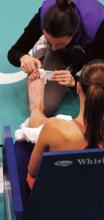Don't miss any stories → Follow Tennis View
FollowTreatments for a blister
Hands and feet can play victim to painful blisters, especially for athletes who endure friction from shoes and racquets.
In everyday life, blisters are usually just a small annoyance, but for a tennis player, they can be extremely painful and can make the difference between a win and a loss.
When Juan Carlos Ferrero experienced foot problems after a match last year, fans learned that blisters were the cause of the pain. “It’s difficult. i couldn't move as normal
because in the long points, i suffer more than I should because my foot feels it at the end of the long points,” explained Ferrero to the press. “so it wasn't easy, but it is what it is.”
Blisters form when the skin has been damaged by friction, such as rubbing or by heat, cold or chemical exposure. For a tennis player, blisters are most likely due to continuous rubbing by shoes or other equipment, like the racquet grip. rafael nadal, however, experienced a bizarre injury before the 2011 Us open when he burnt his fingers on a hot plate and needed bandages to protect blisters.
Regardless of what causes a blister to form, they all start as a small, red, inflamed area. As Dr. Joe Kosterich (m. b. b.s) explains, serous fluid [typically transparent, pale yellow
and benign in nature] then oozes from the layer beneath the skin’s surface and causes a blister to rise and form, separating the layers of skin. Eventually, the blister will either burst, or the body will reabsorb the fluid. the top layer of skin will then shed, and the skin will heal from underneath. the new skin may be sensitive and tender to the touch.
Sometimes blisters may seem inevitable, for instance, when athletes wear new shoes or a tennis match stretches extra long. Kosterich, however, says measures can be taken to help prevent them. simply put, reducing friction reduces the chance of a blister forming.
For the feet, Kosterich stresses the importance of well-fitting shoes. “The key is properly fitted shoes and orthoses if need be. break new shoes in by wearing them for short periods initially and then longer periods as days go by. Wear cotton, padded or thick socks and change socks during a game if it is a long one.”
To avoid blisters on the hands, Kosterich believes the correct grip size is imperative and grips should be changed regularly. “Change your overgrip as often as possible. As a grip loses its grip, it slips, and this creates friction. in turn, it is friction that causes the blister (which is a minor burn from friction),” he says. Kosterich also warns to be cautious of sweat and fluids. moisture softens the skin, which results in less protection, therefore sweat and damp clothing can increase the risk of blisters. Kosterich recommends that grips and hands be dried in between games and sweatbands be worn on the wrist to prevent sweat dripping from the forearms to hands.
 If a blister does form, Kosterich says there is no harm in continuing to exercise as long as you protect the area. “You are limited by your level of discomfort. Treat areas that are tarting to blister by applying a padded or cushioned bandage to protect it from more rubbing,” He advises. As long as the blister is covered, there is no reason a tennis player cannot continue to play – and even win. Case in point: Rafael Nadal.
If a blister does form, Kosterich says there is no harm in continuing to exercise as long as you protect the area. “You are limited by your level of discomfort. Treat areas that are tarting to blister by applying a padded or cushioned bandage to protect it from more rubbing,” He advises. As long as the blister is covered, there is no reason a tennis player cannot continue to play – and even win. Case in point: Rafael Nadal.
- Don’t pop the blister, as this increases the risk of infection.
- If the blister bursts by itself, do not pick the layer of skin off as it protects the new skin from infection.
- Blisters can be protected while playing tennis by applying gauze and tape. Start by padding the blister on all sizes with gauze. Make the gauze thick enough so that it is level with the top of the blister. Put a thinner piece of gauze over top of the blister. Wrap the gauze with a strong adhesive (eg. Duct tape or athletic tape) so the dressing stays in place. You can wrap over top of the blister as long as there is gauze protection.
- After the tennis match, remove any dressings and allow the blister to dry out. Some companies, such as Band-Aid, offer blister specific treatments and pads.
This article is from the Sept / Oct 2012 issue |
|

|
SOLD OUT Subscribe now and you'll never miss an issue!
|










